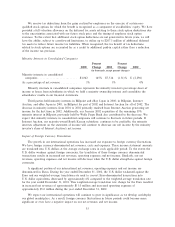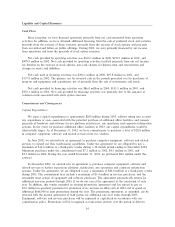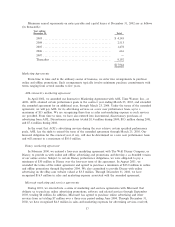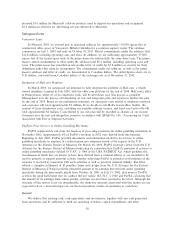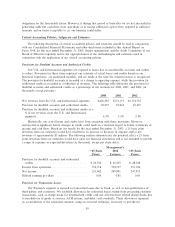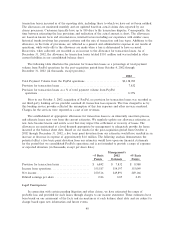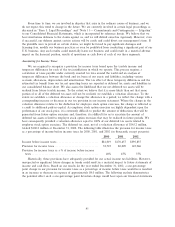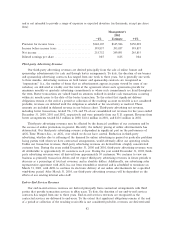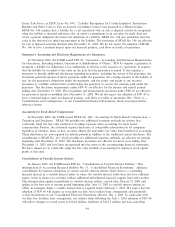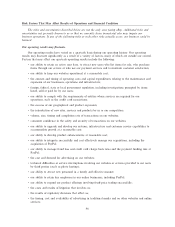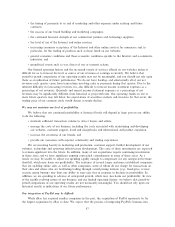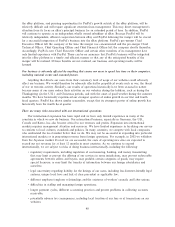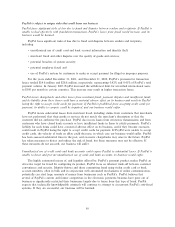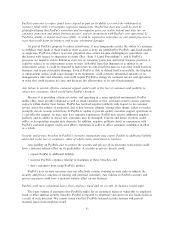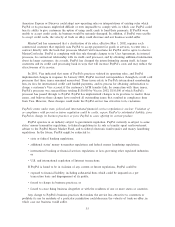eBay 2002 Annual Report Download - page 45
Download and view the complete annual report
Please find page 45 of the 2002 eBay annual report below. You can navigate through the pages in the report by either clicking on the pages listed below, or by using the keyword search tool below to find specific information within the annual report.
the obligation is satisÑed or the uncertainty is resolved. End-to-end services net revenues were 7%, 4% and
2% of our consolidated net revenues for the years ended December 31, 2000, 2001 and 2002, respectively
and were primarily from our U.S. segment.
Similar to our third-party advertising revenues, our end-to-end services revenues may be aÅected by
the Ñnancial condition of the parties with whom we have these relationships and by the success of online
services and promotions in general. Additionally, end-to-end services revenues are also concentrated among
a small customer base. End-to-end services revenues were derived from approximately 10 customers in
2000 and from approximately 20 customers in each of 2001 and 2002. We continue to view our business as
primarily transaction driven and expect end-to-end services revenues in future periods to decrease as a
percentage of total net revenues and in absolute dollars.
Impairment of Long-Lived Assets, Goodwill and Investments
Our long-lived assets at December 31, 2002 are property and equipment of $218.0 million and other
intangible assets of $279.5 million. We evaluate long-lived assets for impairment whenever events or
changes in circumstances indicate that the carrying amount of an asset may not be recoverable in
accordance with SFAS No. 144, ""Accounting for the Impairment or Disposal of Long-Lived Assets.'' An
asset is considered impaired if its carrying amount exceeds the future net cash Öow the asset is expected to
generate. If such asset is considered to be impaired, the impairment to be recognized is measured by the
amount by which the carrying amount of the asset exceeds its fair market value. We assess the
recoverability of our long-lived and intangible assets by determining whether the unamortized balances can
be recovered through undiscounted future net cash Öows of the related assets. The amount of impairment,
if any, is measured based on projected discounted future net cash Öows using a discount rate reÖecting our
average cost of capital.
Our goodwill at December 31, 2002 totaled $1.46 billion. We evaluate goodwill, at a minimum, on an
annual basis and whenever events and changes in circumstances suggest that the carrying amount may not
be recoverable in accordance with SFAS No. 142 ""Goodwill and Other Intangible Assets.'' Impairment of
goodwill is tested at the reporting unit level by comparing the reporting unit's carrying amount, including
goodwill, to the fair value of the reporting unit. The fair values of the reporting units are estimated using a
combination of the income or discounted cash Öows approach and the market approach, which utilizes
comparable companies' data. If the carrying amount of the reporting unit exceeds its fair value, goodwill is
considered impaired and a second step is performed to measure the amount of impairment loss, if any.
To date, we have recorded no impairment of property and equipment, goodwill, or intangible assets.
However, if our estimates or the related assumptions change in the future, we may be required to record
impairment charges in any or all of our three segments to reduce the carrying amount of these assets.
The fair value of long-term investments are dependent on the performance of the companies and
instruments in which we have invested, as well as the volatility inherent in external markets for these
investments. In assessing potential impairment, we consider these factors as well as the forecasted Ñnancial
performance of the companies in which we invest. If forecasted performance levels are not met or if other
events occur, we may have to record additional impairment charges in our U.S. and International segments
to reduce the carrying amount of these assets. During the year ended December 31, 2002, we recognized
$3.8 million of impairment losses relating to the impairment in value of certain equity investments. At
December 31, 2002, the total value of our equity investments in unconsolidated companies was
$44.2 million, with $4.9 million in our U.S segment, $37.5 million in our International segment, and none
in our Payments segment.
Recent Accounting Pronouncements
Accounting for Costs Associated with Exit or Disposal Activities
In June 2002, the FASB issued Statement of Financial Accounting Standards No. 146 or SFAS
No. 146, ""Accounting for Costs Associated with Exit or Disposal Activities,'' which nulliÑes Emerging
43


